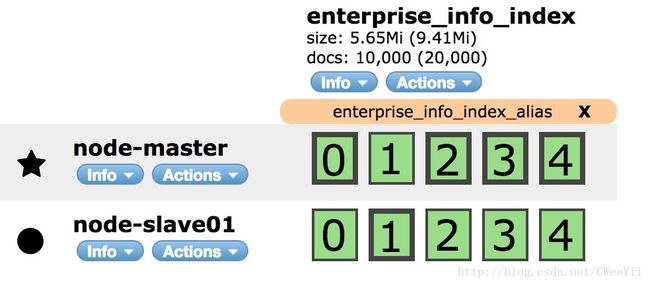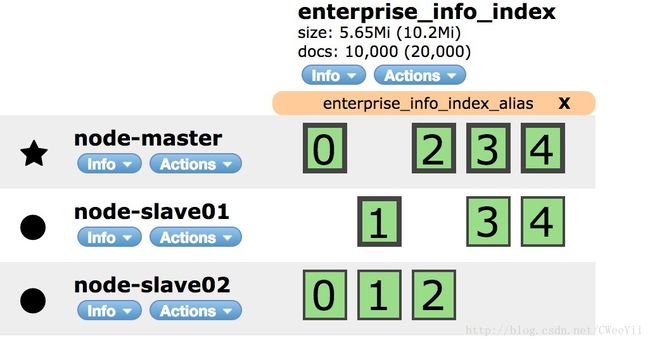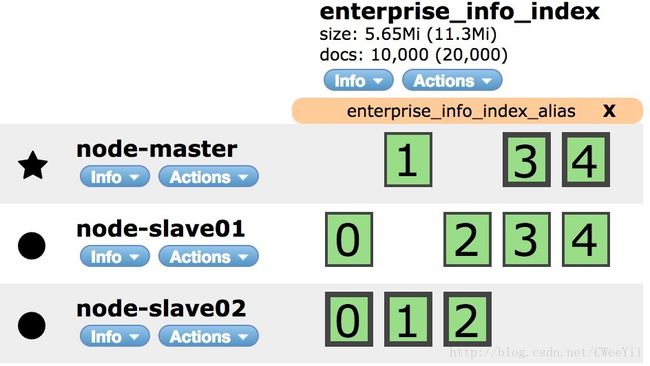集群脑裂问题分析
1.什么是集群脑裂
集群的脑裂通常是发生在集群中部分节点之间不可达而引起的(或者因为节点请求压力较大,导致其他节点与该节点的心跳检测不可用)。当上述情况发生时,不同分裂的小集群会自主的选择出master节点,造成原本的集群会同时存在多个master节点。
2.elasticsearch集群的脑裂
假设已经有安装好elasticsearch集群的三台机器:
192.168.31.88 hadoop-master
192.168.31.234 hadoop-slave01
192.168.31.186 hadoop-slave02其中一台elasticsearch节点hadoop-slave02节点的配置
# ======================== Elasticsearch Configuration =========================
#
# NOTE: Elasticsearch comes with reasonable defaults for most settings.
# Before you set out to tweak and tune the configuration, make sure you
# understand what are you trying to accomplish and the consequences.
#
# The primary way of configuring a node is via this file. This template lists
# the most important settings you may want to configure for a production cluster.
#
# Please consult the documentation for further information on configuration options:
# https://www.elastic.co/guide/en/elasticsearch/reference/index.html
#
# ---------------------------------- Cluster -----------------------------------
#
# Use a descriptive name for your cluster:
#
cluster.name: elasticsearch-cluster
#
# ------------------------------------ Node ------------------------------------
#
# Use a descriptive name for the node:
#
node.name: node-slave02
#
# Add custom attributes to the node:
#
#node.attr.rack: r1
#
# ----------------------------------- Paths ------------------------------------
#
# Path to directory where to store the data (separate multiple locations by comma):
#
path.data: /home/hadoop/workspace/elasticsearch/log/data
#
# Path to log files:
#
path.logs: /home/hadoop/workspace/elasticsearch/log/logs
#
# ----------------------------------- Memory -----------------------------------
#
# Lock the memory on startup:
#
#bootstrap.memory_lock: true
#
# Make sure that the heap size is set to about half the memory available
# on the system and that the owner of the process is allowed to use this
# limit.
#
# Elasticsearch performs poorly when the system is swapping the memory.
#
# ---------------------------------- Network -----------------------------------
#
# Set the bind address to a specific IP (IPv4 or IPv6):
#
network.host: 0.0.0.0
#
# Set a custom port for HTTP:
#
http.port: 9200
#
# For more information, consult the network module documentation.
#
# --------------------------------- Discovery ----------------------------------
#
# Pass an initial list of hosts to perform discovery when new node is started:
# The default list of hosts is ["127.0.0.1", "[::1]"]
#
#discovery.zen.ping.unicast.hosts: ["172.18.157.45"]
discovery.zen.ping.unicast.hosts: ["192.168.31.88"]
#
# Prevent the "split brain" by configuring the majority of nodes (total number of master-eligible nodes / 2 + 1):
#
#discovery.zen.minimum_master_nodes: 3
#
# For more information, consult the zen discovery module documentation.
#
# ---------------------------------- Gateway -----------------------------------
#
# Block initial recovery after a full cluster restart until N nodes are started:
#
#gateway.recover_after_nodes: 3
#
# For more information, consult the gateway module documentation.
#
# ---------------------------------- Various -----------------------------------
#
# Require explicit names when deleting indices:
#
#action.destructive_requires_name: true
index.analysis.analyzer.ik.type : "ik"注意其他节点的配置除去node.name不同外其他都设置都一样。另外由于没有设置节点的node.master和node.data属性(默认都为true),因此该节点既可以存储索引数据又可以成为集群中真正的master节点。另外elasticsearch集群的选举是通过配置文件中的:
discovery.zen.ping.unicast.hosts: ["192.168.31.88"]这里为了测试脑裂的发生,所以这个配置是有问题的,正确的配置是
discovery.zen.ping.unicast.hosts: ["192.168.31.88","192.168.31.234","192.168.31.186"]包含所有可能成为master节点的所有节点,这样可以避免重启导致的脑裂情况。
2.1 elasticsearch索引的变化
首先我们先看下elasticsearch集群在索引上的变化:
只有一个master节点时索引情况:

启动slave01节点时索引情况:

启动slave02节点时索引的情况:

2.2 elasticsearch脑裂分析
elasticsearch集群节点中kill掉slave01节点
hadoop@hadoop-slave01:~/workspace/elasticsearch$ jps
2357 Elasticsearch
2413 Jps
hadoop@hadoop-slave01:~/workspace/elasticsearch$ kill -9 2357
hadoop@hadoop-slave01:~/workspace/elasticsearch$kill掉集群中其中一台机器后,索引重建后的稳定情况

重新启动集群中节点slave01服务:
hadoop@hadoop-slave01:~/workspace/elasticsearch$ bin/elasticsearch -d
hadoop@hadoop-slave01:~/workspace/elasticsearch$重新启动slave01的elastic服务后,三台集群状态:

如下三台机器访问都是相同的集群视图:没有出现脑裂问题
http://hadoop-master:9200/_plugin/head/
http://hadoop-slave02:9200/_plugin/head/
http://hadoop-slave01:9200/_plugin/head/
其中本质上就是通过配置discovery.zen.ping.unicast.hosts来实现。
如果kill master节点之后集群情况:

由于master节点被kill掉后,集群会进行重新的选主,其中slave02被选主成为主节点。同时slave01和slave02的视图都相同。
重新启动master节点后,我们看先elasticsearch的集群情况:
可以发现node-slave01和node-slave02节点的视图没有变化,并没有将重新启动后node-master加入集群中。

我们再看下node-master节点的集群视图:

如下同一个集群就出现了脑裂的情况,node-master、node-slave01、node-slave02中同时出现两个master节点:node-master和node-slave02。至于脑裂产生会出现的问题就是:用户通过node-master进行更新的索引数据,通过node-slave01和node-slave02都不能得到访问。
2.3 elasticsearch解决脑裂
elasticsearch解决脑裂只需要把集群中可能成为主节点的机器节点都配置到elasticsearch的选主配置中:
discovery.zen.ping.unicast.hosts: ["192.168.31.88","192.168.31.234","192.168.31.186"]启动是集群状态:

Kill掉node-master节点后,再重启时集群状态

可以发现elasticsearch的cluster集群在node-master节点失败重启后,重新选node-slave01为主节点。node-master节点重新加入到集群中,并且以node-slave01为主节点,并进行索引的重新分配。